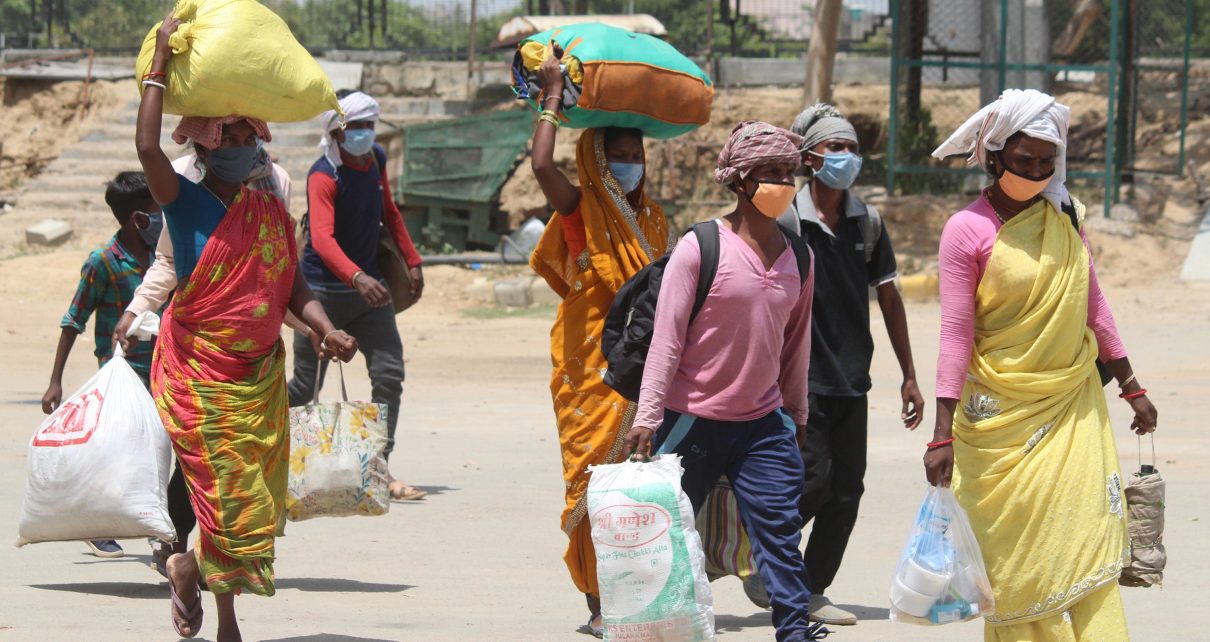On March 24, with only four hours’ notice and no consultation with India’s 29 states, Prime Minister Narendra Modi declared a nationwide lockdown to halt the spread of SARS-CoV-2. Almost all transport and industry came to an abrupt halt, throwing hundreds of millions of workers in the informal sector, who live hand-to-mouth at the best of times—without a regular income, healthcare or other benefits—out of their jobs. Around 40 million were migrant workers, who had travelled from their home states to Delhi and other urban areas in search of employment.
For days stretching into weeks, these men, women and children waited desperately for their workplaces to reopen, but the lockdown was extended repeatedly. Many had not been paid the wages they were owed, and their money and food supplies ran out even as terror of the dreaded new disease and brutal police enforcement of the lockdown stalked them. Giving up hope and desperate to get home to their loved ones, many began to trek for hundreds, even thousands, of kilometers to their home states, carrying their children, elders and belongings.
More than 100 died on the way, of sunstroke, dehydration, starvation, exhaustion and traffic accidents. Pregnant women delivered their babies on highways, picked up their newborns and continued walking in the scorching sun. A group of laborers, who had laid down on railway tracks to sleep in the evident belief that no trains were running, were run over by a goods train; 16 died.
Of these men, half were Adivasis—members of India’s indigenous tribes, who number a little over 100 million. Our ancestral homelands are the forests and fields of central India—a region that, tragically for us, is also rich in mineral deposits. Every year, India forcibly displaces hundreds of thousands of people from their land and other resources to facilitate mining, dam-building and other developmental activities. Roughly 40 percent of the resulting “development refugees” are Adivasis, forced to move to distant urban areas when their nature-based livelihoods were destroyed.
Around 800,000 migrant workers have now returned to Jharkhand, where I live. The state boasts 40 per cent of India’s mineral resources. It is also a textbook example of the resource curse, a term that economists use to describe the poverty and corruption that plagues many regions whose mineral wealth attracts extractive industries. Thousands of mining companies have been operating in the state for decades, producing 160 million metric tons of coal, iron and other minerals annually, worth $2 billion. But none of this wealth trickles down to Adivasis, 60 percent of whom live below the poverty line. Rather the reverse: the mining industry has devastated forests, fields and rivers, displacing millions of people who used to live close to the land.
Any resistance has been ruthlessly suppressed. In 2017, Jharkhand’s Adivasis began a spirited movement to protest forcible land acquisition by the state on behalf of mining companies. They engraved sections of the Indian Constitution that protect Adivasi land rights on stone blocks, which they erected in villages to inform people about their rights. In a bizarre response to this assertion of faith in the Constitution, the Modi government charged 11,200 Adivasis with sedition—a colonial-era law that carries a potential sentence of life imprisonment (and which, ironically, was also used against Gandhi).
Another 20 activists and journalists have also been charged with sedition for the offense of supporting this nonviolent movement. Around 6,000 Adivasis in Jharkhand alone are imprisoned under charges of being Maoist terrorists; almost all these charges are false, according to a study by activist Stan Swamy. And several people have been killed in police firing for defending their land. Thus, it is not only the mining industry but also the state terror that facilitates it that has forced Adivasis from their homes.
Since 2011, I have been working with Adivasis in Saranda, or “land of seven hundred hills.” The largest forest of sal trees in Asia, famous for its elephants, tigers and other wildlife, it originally covered almost 850 square kilometers. Some 25,000 Adivasi families live in it, harvesting forest produce and engaging in shifting agriculture. But under the trees lies an estimated 25 percent of India’s total iron-ore deposits. The exploitation of this resource began in the early 20th century, when a private company, the Tata Group, acquired Adivasi land without proper compensation, forcing the first wave of migration from the region. As mines multiplied, so did the miseries of the forest-dwellers. Currently, 50 leases for iron mining, covering 144 square kilometers, are operational within Saranda forest; and the Jharkhand government has granted 22 more leases, on 94 square kilometers of forest, to national and multinational companies.
In other words, mining is directly converting almost a third of this lush forest into a wasteland. And because deforestation dries up streams, roads crisscross what remains of the forest, and the dust raised by the wheels of thousands of ore-ferrying trucks coats the leaves of trees for miles around, the mines do far more damage than the raw numbers would indicate. They pose an existential threat to the Adivasis and to the region’s irreplaceable wildlife. A 2016 study by the Wildlife Institute of India found steep reductions in the numbers of species of plants, birds and mammals in Saranda; alarmingly, the conservationists could spot not a single elephant.
In principle, Saranda and its inhabitants are protected by the Forest Rights Act of 2006, which gives Adivasis the power to decide how the forests in which they live can be used. But the Jharkhand administration has denied at least 4,000 of the forest-dwellers any identity papers, alleging, falsely, that they are encroachers. My efforts to assist them and other Adivasis who face displacement and state repression have resulted in my being falsely implicated in three police cases and my passport being impounded twice; on one occasion I was even offloaded from a flight to London, where I was to speak at a conference about India’s gross violations of Adivasi rights.
With their forests and fields turning into craters, and streams either drying out or running red with iron-ore dust, unknown numbers of Adivasis were forced to leave Saranda to labor in distant construction sites, brick kilns and other industries. Now COVID-19 is forcing them to return. Some are known to be infected with the virus. Saranda’s villagers have barricaded the trails leading into their hamlets and are not allowing the returnees to enter, even if they are family members. Consequently, a few of these men and women had to live under trees for a few days, where their relatives brought them food, but were later sent to a government-run quarantine center.
Meanwhile, hunger looms. Adivasis, whose natural resources have been appropriated by mainstream society for decades, are already the most malnourished of Indians. With so much of the life-support systems that nature once provided having been willfully destroyed, how will the returnees, evicted twice—once from their homes and then from their workplaces—survive? Who is to be held accountable for their plight?
In early June, when the lockdown finally ended, mining resumed—and with it, the process of generating revenue and refugees.


